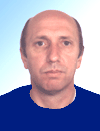Professor Dr. Sc. Mario Valentinov Stoitsov
(1953-2011)

Professor Mario Valentinov Stoitsov, a prominent nuclear theorist, died on August 4, 2011 in Sofia, Bulgaria.
Mario was born in the town of Blagoevgrad, Bulgaria in 1953. He studied at the Faculty of Physics of the “St. Kliment Ohridsky” University of Sofia, receiving his Master’s degree in Atomic and Nuclear Physics in 1978. He subsequently worked at the Laboratory of Theoretical Nuclear Physics of the Institute of Nuclear Research and Nuclear Energy of the Bulgarian Academy of Sciences (Sofia, Bulgaria) as a research scientist (1978-1982), as Assistant Professor (1983-1992), as Associate Professor (1993-1997), and from 1997 as full Professor. He is remembered as having very ably defended both his Ph.D. thesis in 1983, obtained under the supervision of Professor Ivan Zh. Petkov, and his D.Sc. degree in 1993, gained at Sofia.
From his student years, Mario demonstrated his outstanding ability for analytical work in physics and mathematics, as well as his computational skills. Through his work, he became an internationally known theoretician in the field of nuclear structure. The key results of Mario in his “Sofia period” are related to the development (together with Prof. I. Zh. Petkov) of the so-called Local Scaling Transformation Method (his Ph.D. thesis), which has since found numerous applications in the theory of nuclei and their reactions. The method gives a useful recipe with which to obtain the correct asymptotic behavior of nuclear wave functions. This phase of Mario’s works was devoted to the development of the nuclear density functional theory in which he and Prof. I. Zh. Petkov produced pioneering results. Their book “Nuclear Density Functional Theory”, I. Zh. Petkov, M. V. Stoitsov, (Oxford Studies in Physics, Clarendon Press, Oxford, U.K., 1991) is well known.
Mario Stoitsov also obtained important results (together with his colleagues in Sofia) in studying the effects of nucleon-nucleon correlations on the characteristics of nuclear structure and reactions. They primarily concerned the development and usage of natural orbitals and overlap function representations in studies of short-range, tensor, and long-range nucleon correlations and their effects on the nuclear spectral function, the nucleon momentum distribution, and occupation probabilities.
Mario devoted much time and energy to nurturing young scientists and researchers. He also took part in much collaborative work between the Laboratory of Theoretical Nuclear Physics in Sofia and scientists in Oxford, Thessaloniki, Bucharest, Madrid, and Delaware, amongst others. Since 1996, Mario Stoitsov was a member of the American Physical Society.
In the nineties, Mario spent several extended periods at the Technical University of Munich. There he introduced his Local Transformation Method to the modern density functional theory in nuclear physics. This method turned out to be extremely useful in the description of neutron halos and other phenomena of loosely bound open quantum systems, since it elegantly and efficiently combines nuclear structure studies using an oscillator basis with phenomena in the continuum. At this time, he also applied the Generator Coordinate Method to covariant density functional theory. This was pioneering work, which has been extended recently with great success to a fully microscopic description of configuration mixing in low- lying collective spectra on the basis of universal covariant density functionals. The time he spent in Munich was of considerable benefit to the whole group.
At the end of the 1990s, Mario started collaborating with the nuclear theory group from the University of Tennessee at Knoxville (UTK) and Oak Ridge National Laboratory (ORNL). As the collaborative work grew, he moved permanently to Tennessee in November 2001 as a Research Professor at UTK and a key member of the group. The area of his main scientific activity was the nuclear density functional theory, with a strong focus on advanced numerical simulations. To this end, he developed a powerful technique to compute properties of weakly bound nuclei based on the local scaling transformation, developed powerful tools to restore broken particle number symmetry in superfluid nuclei, and performed numerous global calculations of nuclear properties across the chart of the nuclides. Since 2006, Mario was a key member of the UNEDF collaboration, a team of ~50 physicists, computer scientists, and applied mathematicians. His physics knowledge and computational skills resulted in impressive simulations using state-of-the-art supercomputers at ORNL. Among them were global calculations of nuclear properties resulting in microscopic nuclear mass tables, stored by Mario for use by the nuclear community on website massexplorer.org. Within UNEDF, he was also instrumental in studies of novel nuclear functionals, functional optimization, computations of excited states and strength functions, and development of mean-field techniques appropriate to weakly bound systems.
Mario’s work was closely coupled to experimental developments in low-energy nuclear physics, in particular the field of radioactive nuclear beams (RNB). Many of his predictions pertaining to weakly bound nuclei have helped in forming the scientific program of next-generation RNB facilities.
On a personal side, Mario was a good spirit of the Tennessee group. With his friendly, enthusiastic, optimistic attitude, and permanent smile on his face, he was a wonderful mentor for junior researchers in the group, and a sought-after social companion. The UTK/ORNL group enjoyed meeting Mario’s wife Tolya, a prominent Bulgarian psychologist, who visited Knoxville several times.
At the beginning of August 2011, Mario traveled to Sofia to visit Tolya and his two sons, Angel and Valentin, when he suddenly died from a massive stroke.
We will remember Mario Stoitsov for his many scientific contributions on a wide range of topics in nuclear structure physics. He was not only an excellent, internationally renowned physicist but also a very friendly, open-minded, and generous person, sharing his profound knowledge of nuclear theory with others. We shall remember him for his outstanding personal contributions to generations of physicists, his fierce honesty, his remarkable cheerfulness and sense of humor, and his deep commitment to bringing out the best in others. We will miss him!
Anton Antonov, Institute of Nuclear Research and Nuclear Energy, Sofia, Bulgaria
Witek Nazarewicz, University of Tennessee and Oak Ridge National Laboratory, USA
Peter Ring, Technical University Munich, Germany
|